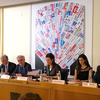Italy celebrates Women's Day
In our own little town of Trevignano Romano, one hour north of Rome, I was startled when, out walking, I passed on the sidewalk a man I barely knew, who suddenly bent to kiss me on both cheeks. "Happy March 8!" he exclaimed. I'd forgotten that it was March 8, when Italy celebrates International Women's Day, not only with friendly kisses, but with sprigs of mimosa everywhere. You can see the scented yellow clusters everywhere -- on lapels, in shop windows and in car windscreens.
And there are other suggested tributes: "Offer her a love song," advised one on-line pundit,
"Make your mamma, girlfriend, wife, daughters and lady friends smile." Also going his own way was Tommaso Fiazza. He is the Northern League mayor of tiny Fontevivo (5,500 souls) near Parma, and passed out pepper spray vials that set the town coffers back some $700. "Obviously mimosa are the symbols of the day, and they are beautiful," he explained.
"But too many women are mistreated or raped, or have their body or dignity violated. We want them to be able to defend themselves." His town, Fiazza added, is a "happy island," where such things don't happen, but who knows what can happen "when they go to Parma or elsewhere." On his Facebook page he wrote that the distribution of anti-aggression spray is to be accompanied by "more street lights, more video surveillance cameras and more municipal police on the beat." Elected at age 20, Fiazza, the youngest mayor in Italy, is now all of 21 but is sometimes still called the "baby mayor," and remembered for having taken out his first Northern League party card when he was just 14. Ironically, he won by defeating two women candidates.
As this shows, Italian women have come a long way, but it was not an easy road. Although back in 1925 women were allowed to vote in local elections, the right for universal women's suffrage came only in 1945, in the wake of World War II. The infamous honor crime (delitto d'onore), which sentenced a man who murdered his wife on grounds of infidelity just two years in prison, was abolished only in 1981. In 1996, the year after Fiazza was born, Parliament voted that rape was not only a crime against morality, but was also a crime against the victim and hence not abstract but personal.
I personally recall reporting for the New York Times on one of the very first meetings of the Movimento per la Liberazione della Donna in Rome. These were the mid-Sixties, and one of the men attending, who was bilingual, insisted upon looking over my notes to make sure I had gotten everything right. He is today a presitigious left-leaning politician and historian, but I confess to having been disagreeably impressed at the notion of male censorship of my coverage of a women's meeting.
In those years most women working in offices and factories were expected to wear a sort of apron-uniform unless they were of a top level. But no one has ever said that Italian women were unaware of fashion, and within a few months these were shed in favor of skimpy short skirts they called the "mini-gonne."
And today? One out of two Italian women has her own salary. According to the ANSA press agency, women who work are now over half the total of all women in Italy, the highest percentage achieved since 1993. Although this does not yet meet the European Union goal, it is a genuine achievement at a time of lingering economicrecession.
Especially the young people of both sexes still have trouble finding jobs, however, and the vast majority of working women are definitely older, between the ages of 55 and 64. There are in today's Italy 1.5 million working women who are over 54 years old, almost a half million more than in 2011. Nevertheless by and large men still find it easier to find a job: in Central Italy during 2015, of those employed 74% were men as opposed to 54%, women. Men also earn more for the same job, and one woman out of three leaves her work after having a child (Istat statistics, in a hearing in the Labor Commission of the Chamber of Deputies).
Regional differences persist, especially in the South. Even in the wealthy Northeast of factories, women make up only 23% of the work force in the Friuli Venezia-Giulia Region and, in the Veneto, just under 20% (2015 partial figures). In both cases the number of working women shows a very slight increase over 2014. On the other hand, with generally high unemployment among the under-forties, the figures are not unimpressive.
Celebrations continue beyond the March 8 remembrance day. On Saturday the unions will hold a a meeting on violence against women, and on that same day in Parma migrant women will meet with Italian women's groups for readings of poetry.






































i-Italy
Facebook
Google+
This work may not be reproduced, in whole or in part, without prior written permission.
Questo lavoro non può essere riprodotto, in tutto o in parte, senza permesso scritto.